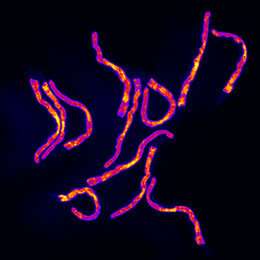Mitochondrial unfolded protein response signals imminent danger

Misfolded proteins must be promptly eliminated as they can form toxic aggregates in cells. LMU biologists have studied how this process is triggered in mitochondria and identified a general alarm signal that activates it.
Proteins can perform their biological functions only if they fold into the correct three-dimensional form. As a rule, this conformation is largely determined by the amino-acid sequence of a protein, but many proteins require accessory factors to fold properly. If protein folding is perturbed (as in the presence of oxidative stress, for instance), not only do inactive proteins accumulate, they can also give rise to highly toxic aggregates. However, cells have evolved a quality-control mechanism that monitors protein folding. If a misfolded protein is detected, a process known as the Unfolded Protein Response (UPR) is activated, which ensures that the protein is degraded and normal cell function is restored. Using the nematode Caenorhabditis elegans as their experimental model, LMU biologists led by Stéphane Rolland have asked how this stress response is triggered in mitochondria, and identified a fundamental mechanism that regulates the UPR in these organelles. Their findings appear in the leading journal Cell Reports.
The UPR machinery is found in several of the diverse membrane-bounded intracellular compartments found in eukaryotic cells, so that errors in protein folding anywhere in the cell can be swiftly dealt with. The mitochondria, which provide the cell with chemical energy, represent one such compartment. Earlier studies on C. elegans had indicated that the transcription factor ATFS-1 plays an important role in initiating the UPR in these organelles. Normally, ATFS-1 is imported into the mitochondria and rapidly degraded. However, when mitochondria are under stress, the protein is re-routed to the cell nucleus. There it activates the transcription of genes which code for proteins that implement the UPR in mitochondria. Moreover, this signaling pathway has been evolutionarily conserved, at least in part, from nematodes to mammals.
"Up to now, the precise nature of the signal that triggers this cellular stress response was not fully understood," Rolland explains. "We therefore carried out an extensive genome-wide screen designed to systematically identify all the genes and biological processes that are involved in the activation of the UPR in mitochondria." The screen showed that inactivation of 171 genes activate the UPR in mitochondria, and many of their protein products are localized in mitochondria. Furthermore, inactivation of many of these genes leads to a reduction in the level of the electrochemical potential across the mitochondrial inner membrane. This drop in mitochondrial membrane potential is accompanied by a decrease in the rate of protein import into the organelle, which is then followed by activation of the UPR. "We believe that the decrease of mitochondrial membrane potential serves as a general signal for the induction of the mitochondrial UPR," says Rolland.
Mitochondrial proteins contain a N-terminal amino-acid sequence that is responsible for their targeting to mitochondria. These so called mitochondrial targeting sequences can be "strong" or "weak" depending on their amino-acid composition. While proteins with "strong" mitochondrial targeting sequences can be imported into mitochondria even with a low membrane potential, proteins with "weak" mitochondrial targeting sequences cannot. Rolland and colleagues propose that the transcription factor ATFS-1, which has a "weak" mitochondrial targeting sequence, acts as a sensor, which detects and reacts to a decline in mitochondrial membrane potential. If the potential becomes abnormally low, import of ATSF-1 into the mitochondria is blocked. The resulting rise in its concentration in the cytoplasm then leads to its uptake into the nucleus, where it activates the transcription of genes necessary for the mitochondrial UPR. The proteins encoded by these genes have "strong" mitochondrial targeting sequences and can therefore be imported into mitochondria despite their low membrane potential in order to restore mitochondrial function.
More information: Stéphane G. Rolland et al. Compromised Mitochondrial Protein Import Acts as a Signal for UPRmt, Cell Reports (2019). DOI: 10.1016/j.celrep.2019.07.049
Journal information: Cell Reports
Provided by Ludwig Maximilian University of Munich




















